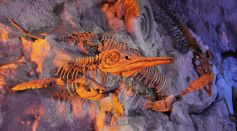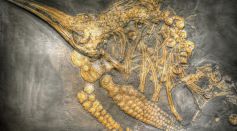Tags: Mass extinction
![Humans Will Go Extinct on Earth in 250 Million Years; Mass Extinction Will Occur Sooner if Burning Fossil Fuels Continues [Study]](https://d.sciencetimes.com/en/full/53373/humans-will-go-extinct-earth-250-million-years-mass-extinction-will-occur-sooner-if-burning.jpg?w=237&h=131&f=2ed0c44aa235857ce98eff3cd7e63920)
Humans Will Go Extinct on Earth in 250 Million Years; Mass Extinction Will Occur Sooner if Burning Fossil Fuels Continues [Study]
Dinosaurs Thrived in Africa Prior to Asteroid Impact, New Fossils Suggest
Next Mass Extinction on the Verge of Happening? Unsustainable Human Activities a Threat to 20% of Migratory Animals
66-Million-Year-Old Fossil Reveals New Dinosaur Roaming in the US Before Mass Extinction
Mass Extinction Level Event: 5 Global Incidents That Wiped Out Millions of Species

Earth Now Closer to Mass Extinction With Nearly 50% of Animals Facing Drastic Declines in Population

'Chicxulub Impact' Asteroid That Killed Dinosaurs May Not Have Led to 'Nuclear Winter,' New Study Says
Oxygen Depletion, Hydrogen Sulfide Expansion in Ancient Seas May Have Caused One of Earth's Mass Extinction Events

Volcanic Eruption and Severe Eradication: Mercury Analyses Shed Light on Earth's Worst Extinction

Dinosaurs Could Have Been Declining 2 Million Years Before the Asteroid Impact, Study Reveals

Climate Change Causes Mass Extinctions: Humans, Animals, Plants Species May Have Shorter Time to Adapt

Great Dying: The Earth's Largest-Ever Mass Extinction Led to Evolution Resulting in Faster and Smarter Animal Species

Mass Extinction Effects Analyzed by Social Networking Algorithm for Fossils

Fish Bones Reveal Dinosaur-Killer Chicxulub Hit the Earth During Spring 66 Million Years Ago

Earth’s First Giants: Ichthyosaurs Evolved Into Massive Marine Reptiles Faster Than Whales

Volcanoes That Ignited "The Great Dying" Mass Extinction 250 Million Years Ago Revealed
What Caused the End-Ordovician Mass Extinction? Cooling Climate Might Be Responsible Not the Lack of Oxygen

Snakes Expanded Their Dietary Plan After Dinosaur Mass Extinction 66 Million Years Ago
Unknown Eocene-Oligocene Mass Extinction that Wiped Out 60 Percent of Mammals Discovered for the First Time

'Toxic Soup' Ingredients in Permian-Triassic Mass Extinction Now Available in Modern Age, Study Says
Most Popular

How Strong Are Tornadoes? Understanding the EF Scale and the Extreme Power Tornadoes

Glaciers Are Melting Fast: Climate Change Impact Driving Sea-Level Rise Worldwide

How Telescopes Work: Optical vs Radio vs Space Telescope Science Explained

Can the World Run Out of Water? Water Scarcity Science and Climate Impact Explained





